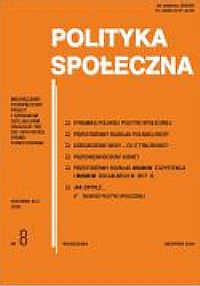
- Diary of Social Policy
- The analysis of trends of the changes in the implementation of Polish social policy by using foresight method (2-9)
The purpose of this paper is to analyse the trends of changes in Polish social policy and designing visions of its development from perspective of its selected stakeholders. The article is based on results of research conducted by the University of Wrocław research team in the framework of the project Innovative Social Investment Strengthening Communities in Europe (InnoSI), financed by the European Commission, under the Horizon 2020 Programme. Particularly, it wants to explore foresight method implementation in research process, encompassing: local signals scanning, identification main trends of social changes, building scenarios of future Polish social policy towards selected stakeholders in the 10-year perspective.
- Changes in risk of poverty and social exclusion levels in Polish
The goal of the article was an analysis of changes in risk of poverty and social exclusion levels in Polish voivodeships in two subperiods: 2005–2006 and 2014–2015, based on the usage of taxonomic methods (mainly: measurement of Euclidean distances between object in a multi-dimensional space and agglomerative hierarchical clustering (AHC)). A as result of the analysis, for both sub-periods, clusters of voivodeships characterized by similar risk of poverty and social exclusion levels have been identified, and a ranking of voivodeships has been created (based on their distance to the low-level-of-risk standard). The analysis allowed also to identify changes in this ranking, occurring between sub-periods.
- Pulling or pushing? On the motives of starting a business by women (18-23)
Poland with a percentage of 33.4% is among the top countries in terms of the percentage of companies run by women. Availability of capital, public policy, education and training are some of the factors constituting framework conditions for entrepreneurship, within which motivations of women to make decisions about starting their own business arouse. Some of these motives are positive, in literature they are referred to as “pull factors”, and include, among others, the need for independence, the desire to earn higher income or fulfill their professional aspirations. Other motives have a negative connotation and are called „push factors”, forcing them to create a workplace for themselves. These include, for example, lack of employment opportunities or lack of satisfaction with wage labour. In the article, on the basis of the analysis of literature and research results, the determinants of entrepreneurship development and the motives behind setting up a business are described. This article deals with why women decide to start their own business. What pushes or attracts them to run their own business.
- Innovation in the existing local dysfunctions of social policy. Experiences from works on the universal model of counteracting the inheritance of poverty (24-35)
The article includes a description of the experiences of researchers who undertook as part of the project to create a universal model to counteract the inheritance of poverty among residents of the degraded area of the city. Sociologists faced the challenge of overcoming numerous barriers as part of the work on the model (lying on the side of members of the target group, representatives of local institutions, or resulting from formal decisions and decisions within the grant competition and the project itself). The article presents both theoretical inspirations that were reflected in the model’s construction (primarily the original approach to social exclusion and the essence of the empowerment model), conclusions from the diagnosis carried out in the environment in which the model is to be implemented, description of the model’s main assumptions, and also the barriers encountered by work on the model and potential implementation barriers.
- Regional estimates of subsistence minimum baskets (ME) and social minimum baskets (MS) for 2017 (36-40)
The article discusses regional estimates of subsistence minimum and social minimum based on average prices of 2017. Subsistence minimum defines the lowest possible level of consumption allowing the households to survive, while Social minimum defines a model category allowing the minimum level of decent life, necessary for social integration. Between these two extremes there is a sphere of scarcity. In 2017 the scale of the span of subsistence minimum in voivodeships has slightly weakened. The highest value of the subsistence minimum for a family with 2 children was recorded in the province Lower Silesia (+5.8% above the average for Poland) and West Pomeranian (+4.6%), while the lowest in Podkarpackie and Lubelskie provinces (-5% below the average value). The highest social minimum values for a family with 2 children was assessed for the provinces of Dolnośląskie (+4.4% more than the national average) and West Pomeranian (+3.8%). The lowest values of social minimum have occurred in the province Kujawsko-Pomorskie (-4.6%), Podkarpackie and Lubelskie (-3.4%).
Polityka Społeczna (Social Policy) - full list







